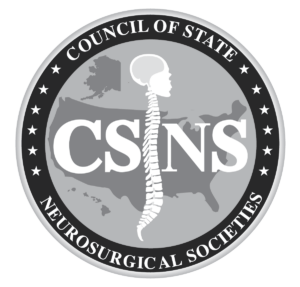DiGiorgio
2023 CSNS Meeting Recap
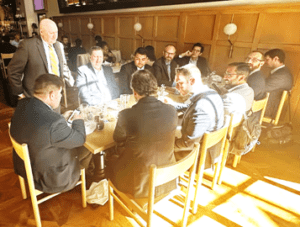
The 2023 Spring CSNS meeting was a tremendous triumph, starting off with a casual yet invigorating Fellows breakfast at Café Fig. The fellows emanated an infectious energy and enthusiasm that set the tone for the ensuing conference. The Café Fig menu was uniquely Californian. Where else can one order coffee infused with grass-fed ghee and beet oil?
The plenary session showcased reports from Dr. Ratliff, the Vice-Chair, Dr. Mazzola, the Treasurer, Dr. Tumialan, the Corresponding Secretary, Dr. Phelps, the Recording Secretary, and Dr. Watridge, the Historian. These were their final reports as this set of officers, as new elections appointed Dr. Ratliff as Chair, Dr. Tumialan as Vice-Chair, Dr. Mazzola as Corresponding Secretary, Dr. Schirmer as Recording Secretary, and Dr. Benzil as Historian. This team promises to uphold the organization’s high standards of leadership.
The meeting also spotlighted the diverse work of our fellows through several special reports. Dr. Sharma shared insights on factors influencing retirement and workforce attrition. Dr. Shlobin spoke about the safety of lifting patients in the operating room. Dr. Vessell discussed diversity and intersectionality in neurosurgery match procedures, while Stefan Koester shed light on the cost-effectiveness of MMA embolization. Additionally, Dr. Shirmer reviewed the impact of COVID-19 on payer landscapes.
The meeting also spotlighted the diverse work of our fellows through several special reports. Dr. Sharma shared insights on factors influencing retirement and workforce attrition. Dr. Shlobin spoke about the safety of lifting patients in the operating room. Dr. Vessell discussed diversity and intersectionality in neurosurgery match procedures, while Stefan Koester shed light on the cost-effectiveness of MMA embolization. Additionally, Dr. Shirmer reviewed the impact of COVID-19 on payer landscapes.
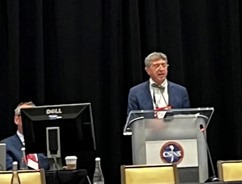 On the second day, the plenary session included updates and reports from Dr. Cheng, Katie Orrico, Dr. Levy, and Dr. Stroink. One highlight was the presentation of the Leibrock Lifetime Achievement Award to Dr. Abou-Samra. Known for his dedication to neurosurgery and advocacy, Dr. Abou-Samra serves as an inspiring example for all. He continues to be actively engaged with the CSNS and CANS, and his receipt of the award is well-deserved.
On the second day, the plenary session included updates and reports from Dr. Cheng, Katie Orrico, Dr. Levy, and Dr. Stroink. One highlight was the presentation of the Leibrock Lifetime Achievement Award to Dr. Abou-Samra. Known for his dedication to neurosurgery and advocacy, Dr. Abou-Samra serves as an inspiring example for all. He continues to be actively engaged with the CSNS and CANS, and his receipt of the award is well-deserved.
The resolution debate at the Spring 2023 CSNS meeting was, as expected, both thoughtful and exciting. The consent calendar, put together by the reference committee, was adopted almost without changes. Eighteen resolutions were proposed in total, but only three – Resolution 6, Resolution 7, and the emergency resolution – were extracted for debate. The other recommendations were readily adopted, reflecting the diligent work of the resolution committee under Dr. Ratliff’s leadership.
A summary of the resolutions and their debate follows here.
Resolution 1 took aim at hospital medical staff independence and due process. It had broad support and Dr. Mark Linskey gave personal testimony on the importance of medical staff independence from the hospitals. Medicolegal and medical directors all supported as well. Katie Orrico noted that the AMA already has policy regarding this. It was amended by the reference committee and adopted.
Resolution 2 was the first of two resolutions specifically targeting hospital administration, making hospital administrators subjected to licensure requirements. The CNS caucus thought this might be too difficult. Ultimately, the resolution was amended by the reference committee and adopted.
Resolution 3 sought to measure and reduce the electronic health record burden in neurosurgery. It received broad support and was adopted without amendments.
Resolution 4 revolved around improving financial literacy for neurosurgery trainees. It received broad support from the Washington Office, Medical practices, YNC and Senior caucus. It was ultimately combined with resolution 12 and passed.
Resolution 5 proposed studying the prevalence of defensive medicine within neurosurgery, and its association with burnout. It was supported by CEC, CANS, workforce and Washington Office. It was amended and passed.
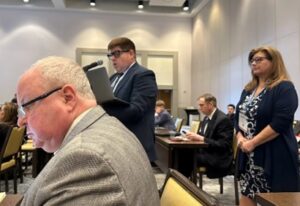 Resolution 6 addressed delays in the surgical billing cycle and reimbursement process. Katie Orrico noted that CMS has a new rule stating plans can’t use retroactive rejection. The patient safety committee wanted more information on denial rate. It had broad support from CANS, medicolegal, YNS, CRC and medical directors. It was extracted from the consent calendar to add a safety component and ultimately passed.
Resolution 6 addressed delays in the surgical billing cycle and reimbursement process. Katie Orrico noted that CMS has a new rule stating plans can’t use retroactive rejection. The patient safety committee wanted more information on denial rate. It had broad support from CANS, medicolegal, YNS, CRC and medical directors. It was extracted from the consent calendar to add a safety component and ultimately passed.
Resolution 7 looked at getting spine emergencies where they need to be with a “spine attack” program. This was largely supported in spirit but ultimately opposed by many groups, including CANS, workforce, NTENS and medical directors. It was not passed.
Resolution 8 looked to examine the border wall and its effect on neurotrauma. This was hotly debated. It was opposed by CEC, YNC and Medicolegal. CANS remained neutral while medical directors supports. It was recommended for rejection by the reference committee. However, it was extracted from the consent calendar and debated further. It was ultimately passed by a slim margin.
Resolution 9 sought to examine the impact of travel nurses. It was op[osed by CANS, the CNS caucus and Medical Practices. Despite this, it was recommended for adopted as written by the reference committee and passed.
Resolution 10 examined the upcoming Medicare fee schedule and quality payment program changes and how that would affect neurosurgeon revenue. It recommended having the CNS/AANS educate its members on new changes to CMS rules. Specifically, it addressed the change that assumes PA/NP time is equivalent to MD/DO time and how that would affect office visit billing. It had broad support and was ultimately passed after amendment by the reference committee.
Resolution 11 examined neurotrauma and acute care readiness in military neurosurgery trainees. This saw broad support and some felt it would fit nicely with the federal program “Remission Zero” which aims to improve collaboration between civilian and military practices. It was passed after amendment.
Resolution 12 also addressed financial literacy for trainees. It was combined with resolution 4, which passed.
Resolution 13 sought to create an online repository for posting open research positions. This was opposed by YNS, workforce and CEC. CANS remained neutral and medicolegal supported. It was not passed.
Resolution 14 was aimed at quality metrics, suggesting that hospital administrations be judged by quality metrics similar to how frontline providers are. It was too antagonistic for some groups which opposed on those grounds, such as workforce committee and YNC. It did receive broad support from medical practices, medical directors, medicolegal, CANS and the Washington Committee. It was passed after being amended.
Resolution 15 also sought to improve transparency and accountability for hospital systems. The national provider databank was specifically called out for being abused. This had support from medical practice, medical directors, medicolegal and CANS. It was ultimately passed after being amended.
Resolution 16 wanted to examine private equity in neurosurgery. This timely resolution had nearly unanimous support and was passed as written.
Resolution 17 looked at the current practices in global and humanitarian neurosurgery. Some individual testimony questioned if this work was already being done, but the committees nearly unanimously supported it. It was passed as written.
The emergency resolution looked to repeal the AANS/CNS vaccination requirement for in-person meetings. This had vigorous debate. Although it was supported by many in spirit, it was ultimately not passed.

